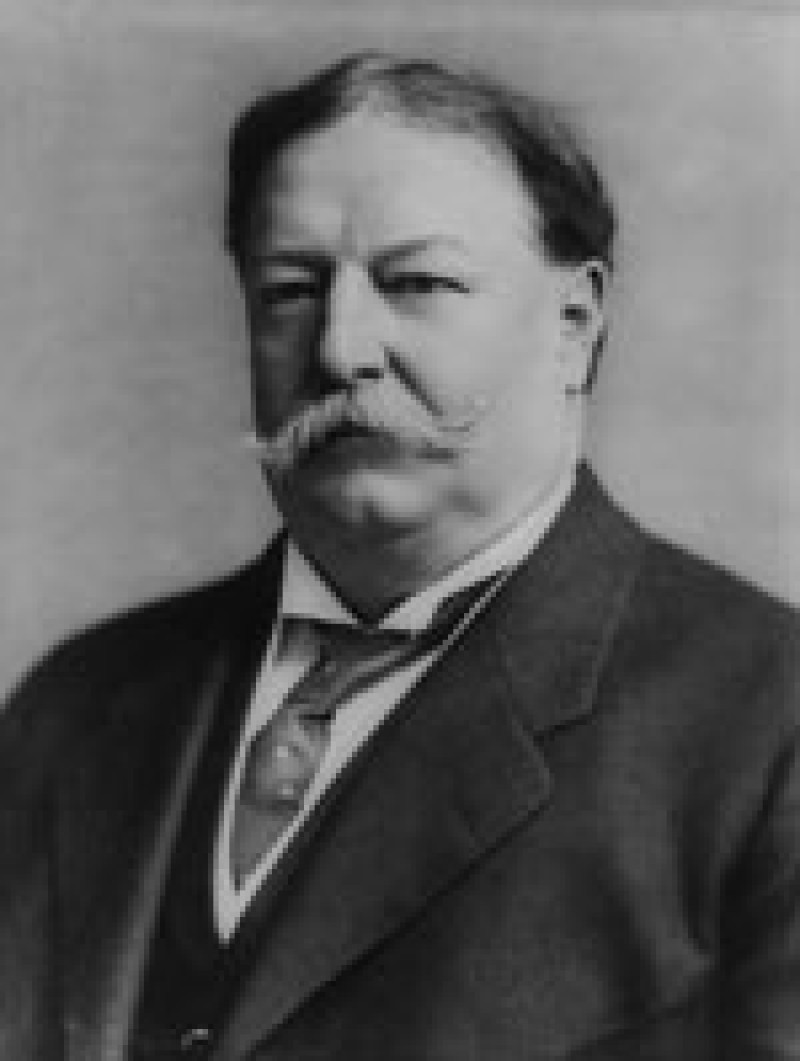William Howard Taft (Sept. 15, 1857 - March 8, 1930)
William Howard Taft, 27th president of the United States and chief justice of the United States, was born in Cincinnati, Ohio. Taft attended Yale University, from which he graduated second in his class in 1878.
Becoming a lawyer was a natural step for Taft, and he studied at the Cincinnati Law School where he graduated with the class of 1880. Admitted to the bar in Ohio, he combined politics with his practice. He campaigned for Republican candidates during the election of 1880 and served briefly as an assistant prosecuting attorney for Hamilton County.
In 1887 Governor Joseph B. Foraker named Taft to the superior court of Ohio. He won election to a five-year term in 1888. While still in his early 30s, he was mentioned for the U.S. Supreme Court. Taft was named solicitor general by President Benjamin Harrison (1833-1901) in February 1890. After a year in the post, where he won 15 of the 18 cases he argued before the Supreme Court, he was appointed to the federal circuit for the 6th District, where he served from March 1892 until 1900.
With Theodore Roosevelt (1858-1919) as president after September 1901, Taft received two offers to become a justice of the Supreme Court. He declined both invitations but agreed to become Roosevelt's secretary of war in 1904.
Since Roosevelt had said that he would not run in 1908, Taft's name was mentioned as his successor frequently during 1905 and 1906. He was nominated on the first ballot, and James S. Sherman, a conservative congressman from New York, became his running mate. Taft campaigned effectively against his Democratic opponent, William Jennings Bryan, and won the contest with an electoral vote of 321 to Bryan's 162.
The public saw in Taft a large, genial president whose weight sometimes reached 300 pounds. He had a strong ability to judge character when his emotions were not at stake. Although inclined sometimes to procrastinate, Taft usually worked hard at his job.
In the presidential race against Roosevelt and the Democratic candidate, Woodrow Wilson, Taft followed the custom that incumbent presidents did not campaign for re-election. It would not have mattered what he did. With the Republican party out of money, and its normal vote split between Roosevelt and Taft, a Democratic triumph was inevitable. Taft carried Vermont and Utah, for eight electoral votes. He finished behind Wilson and Roosevelt in the popular vote as well.
Taft accepted defeat gracefully. From 1913 to 1921 he was the Kent Professor of Constitutional Law at Yale. He also wrote extensively and lectured on the presidency. His most enthusiastic commitment was to the League to Enforce Peace, an organization that lobbied for a League of Nations between 1916 and 1919.
Taft never lost his desire to serve on the Supreme Court, and the election of a Republican president, Warren G. Harding, in 1920 gave him his chance. The president nominated him in June 1921, and the Senate confirmed him as chief justice of the United States with only four negative votes.
Taft's judicial record reflected his conservatism. He wrote the majority opinion in Bailey v. Drexel Furniture Company (1922), which overturned the law that taxed products made with child labor in interstate commerce. He also upheld the power of the federal government to regulate interstate commerce in the case of Stafford v. Wallace (1922), and he endorsed the power of the president to fire members of the executive branch in Myers v. United States (1926).
By early 1930, Taft's health was failing; he retired from the court on Feb. 3, 1930. He died in Washington, D.C. Taft's presidency was not a political success, and he has been regarded as a failure between the more impressive administrations of Roosevelt and Wilson. More of a judge than a popular leader, Taft was happiest during the years that he served as chief justice. The only person to hold both of these offices in the nation's history, Taft served the United States with efficiency and achievement during his impressive public career.
Some content and graphic elements featured on webpages related to the Thomas J. Moyer Ohio Judicial Center were used with the permission of the Ohio Historical Society; the Prints and Photographs Division of the Library of Congress; the Office of the Curator of the Supreme Court of the United States and American National Biography Online.
Biography of William Howard Taft (Sept. 15, 1857 - March 8, 1930)
Citation: Lewis L. Gould. "Taft, William Howard"; http://www.anb.org/articles/06/06-00642.html; American National Biography Online Feb. 2000. Access Date: Fri Oct 3 09:53:20 2003. Copyright © 2000 American Council of Learned Societies. Published by Oxford Univeristy Press. All Rights Reserved.
Portrait of William H. Taft - Library of Congress, Prints & Photographs Division.

